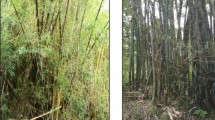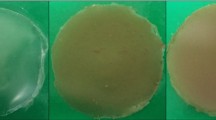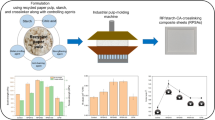Abstract
Plastic bags are widely used and significantly contribute to plastic pollution. Alternative bio-bags developed from natural and renewable sources are urgently needed to solve this problem. This study aimed to develop and characterise bio-sheets developed from sugarcane bagasse, which is an agricultural residue, for potential use as bio-sheet packaging material. Bio-sheets were developed from sugarcane bagasse at varying conditions of temperatures at 150°C, 160°C and 170°C. Starch content was varied at 2%, 4% and 6% and resin content at 1.25%, 2.5% and 3.75% of total weight. Developed bio-sheets were tested for their strength properties, wetting resistance and water absorption behaviour. Response surface methodology at optimised conditions of temperature at 160°C, 3% starch content and 3.75% resin content, showed that the bio-sheets at the optimised conditions had adequate physical properties with strip strength of 25.3 kgf, tear strength of 0.34 kgf, bursting strength of 2.39 kgcm−2, stiffness of 11 kgf and water absorption of 156%. Wetting resistance of ISO 2 which falls within the international standard of 100–160% was also observed. These properties suggest that the sugarcane bagasse bio-sheets can be optimised for the development of bio-bags.










Similar content being viewed by others
Data availability
All data is available upon reasonable request made to the corresponding author.
References
UNEP (2018) Single-use plastics: a roadmap for sustainability. https://www.unep.org/resources/report/single-use-plastics-roadmap-sustainability
Behuria P (2021) Ban the (plastic) bag? Explaining variation in the implementation of plastic bag bans in Rwanda, Kenya and Uganda. Environ Plan C Polit Sp 39:1791–1808. https://doi.org/10.1177/2399654421994836
Kumar R, Verma A, Shome A et al (2021) Impacts of plastic pollution on ecosystem services, sustainable development goals, and need to focus on circular economy and policy interventions. Sustain 13:9963. https://doi.org/10.3390/su13179963
Howell EA, Bograd SJ, Morishige C et al (2012) On North Pacific circulation and associated marine debris concentration. Mar Pollut Bull 65:16–22. https://doi.org/10.1016/j.marpolbul.2011.04.034
Plastics Europe (2021) Plastics - the Facts 2018. https://plasticseurope.org/wp-content/uploads/2021/10/2018-Plastics-the-facts.pdf
Kubowicz S, Booth AM (2017) Biodegradability of plastics: challenges and misconceptions. Environ Sci Technol 51:12058–12060. https://doi.org/10.1021/acs.est.7b04051
Tsui TH, Wong JWC (2019) A critical review: emerging bioeconomy and waste-to-energy technologies for sustainable municipal solid waste management. Waste Dispos Sustain Energy 1:151–167. https://doi.org/10.1007/s42768-019-00013-z
knoema (2020) Uganda - sugar cane production quantity. https://knoema.com/atlas/Uganda/topics/Agriculture/Crops-Production-Quantity-tonnes/Sugar-cane-production.
Hamin SH, Abdullah SHYS, Lananan F et al (2023) Effect of chemical treatment on the structural, thermal, and mechanical properties of sugarcane bagasse as filler for starch-based bioplastic. J Chem Technol Biotechnol 98:625–632. https://doi.org/10.1002/jctb.7218
Miranda NT, Motta IL, Filho RM et al (2021) Sugarcane bagasse pyrolysis: a review of operating conditions and products properties. Renew Sustain Energy Rev 149:111394. https://doi.org/10.1016/j.rser.2021.111394
Sluiter JB, Chum H, Gomes AC et al (2016) Evaluation of Brazilian sugarcane bagasse characterization: an interlaboratory comparison study. J AOAC Int 99:579–585. https://doi.org/10.5740/jaoacint.15-0063
Pereira PHF, Voorwald HCJ, Cioffi MOH et al (2011) Sugarcane bagasse pulping and bleaching: thermal and chemical characterization. BioResources 6:2471–2482. https://doi.org/10.15376/biores.6.3.2471-2482
Madhu P, Sanjay MR, Jawaid M et al (2020) A new study on effects of various chemical treatments on agave Americana fiber for composite reinforcement: physico-chemical, thermal, mechanical and morphological properties. Polym Test 85:106437. https://doi.org/10.1016/j.polymertesting.2020.106437
Costa MAM, Schiavon NCB, Felizardo MP et al (2023) Emission analysis of sugarcane bagasse combustion in a burner pilot. Sustain Chem Phar 32:101028. https://doi.org/10.1016/j.scp.2023.101028
Mittal V, Sinha S (2015) Effect of chemical treatment on the mechanical and water absorption properties of bagasse fiber-reinforced epoxy composites. J Polym Eng 35:545–550. https://doi.org/10.1515/polyeng-2014-0270
Van Soest PJ, Robertson JB, Lewis BA (1991) Methods for dietary fiber, neutral detergent fiber, and nonstarch polysaccharides in relation to animal nutrition. J Dairy Sci 74:3583–3597. https://doi.org/10.3168/jds.S0022-0302(91)78551-2
ASTM D 3786/D3786 (2018) Standard test method for bursting strength of textile fabrics-diaphragm bursting strength tester method, D 3786/D3786 M-13. https://doi.org/10.1520/D3786_D3786M-18
ASTM D (2017) Standard test method for tearing strength of fabrics by the tongue (Single rip) procedure (Constant-rate-of-extension tensile testing machine). https://doi.org/10.1520/D2261-13R17E01
ASTM D (2019) Standard test method for breaking force and elongation of textile fabrics (strip method). Annu B ASTM Stand 7:675–681. https://doi.org/10.1520/D5035-11R19
ASTM D (2016) Standard test method for stiffness of fabric by the circular bend procedure. https://doi.org/10.1520/d4032-08r16
ASTM D-1777 (2019) Standard test method for thickness of textile materials. https://doi.org/10.1520/D1777-96R19
ASTM D-22a (2022) Standard test method for flammability of apparel textiles. https://doi.org/10.1520/D1230-22A
Annual Book of ASTM Standard (2018) Standard method for water absorption of plastics D-570,-98. 8:1–3. https://doi.org/10.1520/D0570-98R18.2
AATCC 22 (2017) TM022-TM22-TM 22 Water repellency: spray test
Das BK, Haque SMN, Kader MA, Rahman S (2013) Prospects of bagasse gasification technology for electricity generation in sugar industries in Bangladesh. Int Conf Mech Ind Mater Eng, Rajshahi, Bangladesh, Novemb 1-3:268–272
Dhakal HN, Zhang ZY, Richardson MOW (2007) Effect of water absorption on the mechanical properties of hemp fibre reinforced unsaturated polyester composites. Compos Sci Technol 67:1674–1683. https://doi.org/10.1016/j.compscitech.2006.06.019
Rhim JW (2010) Effect of moisture content on tensile properties of paper-based food packaging materials. Food Sci Biotechnol 19:243–247. https://doi.org/10.1007/s10068-010-0034-x
Mahmud MA, Anannya FR (2021) Sugarcane bagasse-a source of cellulosic fiber for diverse applications. Heliyon 7:e07771. https://doi.org/10.1016/j.heliyon.2021.e07771
Plermjai K, Boonyarattanakalin K, Mekprasart W et al (2018) Extraction and characterization of nanocellulose from sugarcane bagasse by ball-milling-assisted acid hydrolysis. AIP Conf Proc 2010:020005. https://doi.org/10.1063/1.5053181
Hartley RD (1972) p-Coumaric and ferulic acid components of cell walls of ryegrass and their relationships with lignin and digestibility. J Sci Food Agric 23:1347–1354. https://doi.org/10.1002/jsfa.2740231110
Łojewski T, Ziȩba K, Knapik A et al (2010) Evaluating paper degradation progress. Cross-linking between chromatographic, spectroscopic and chemical results. Appl Phys A Mater Sci Process 100:809–821. https://doi.org/10.1007/s00339-010-5657-5
Worku LA, Bachheti A, Bachheti RK et al (2023) Agricultural residues as raw materials for pulp and paper production: overview and applications on membrane fabrication. Membranes (Basel). 13:228. https://doi.org/10.3390/membranes13020228
Nithikarnjanatharn J, Samsalee N (2022) Effect of cassava pulp on physical, mechanical, and biodegradable properties of Poly(Butylene-Succinate)-Based biocomposites. Alexandria Eng J 61:10171–10181. https://doi.org/10.1016/j.aej.2022.03.052
Pego MFF, Bianchi ML, Yasumura PK (2022) Physical and mechanical properties of papers produced from different cellulosic pulps blending. Res Sq. https://doi.org/10.21203/rs.3.rs-2257060/v1
Wang S, Zhang F, Chen F, Pang Z (2013) Preparation of a crosslinking cassava starch adhesive and its application in coating paper. BioResources 8:3574–3589
Sederavičiūtė F, Domskiene J, Baltina I (2019) Influence of drying temperature on tensile and bursting strength of bacterial cellulose biofilm. Mater Sci (Medžiagotyra) 25:316–321. https://doi.org/10.5755/j01.ms.25.3.20764
Hubbe M (2006) Bonding between cellulosic fibers in the absence and presence of dry-strength agents – a review. BioResources 1:281–318. https://doi.org/10.15376/biores.1.2.281-318
Shotton E, Harb N (1966) The effect of humidity and temperature on the cohesion of powders. J Pharm Pharmacol 18:175–178. https://doi.org/10.1111/j.2042-7158.1966.tb07844.x
Strand A, Khakalo A, Kouko J et al (2017) The effect of chemical additives on the strength, stiffness and elongation potential of paper. Nord Pulp Pap Res J 32:324–335. https://doi.org/10.3183/npprj-2017-32-03-p317-323
Autio K, Poutanen K, Suortti T, Pessa E (1992) Heat-induced structural changes in acid-modified barley starch dispersions. Food Struct 11:315–322
Winotapun C, Phattarateera S, Aontee A et al (2019) Development of multilayer films with improved aroma barrier properties for durian packaging application. Packag Technol Sci 32:405–418. https://doi.org/10.1002/pts.2452
Islam MR, Mia R, Uddin AJ (2022) Investigation of the performance of okra fiber in woven fabric. Heliyon 8:e09307. https://doi.org/10.1016/j.heliyon.2022.e09307
Songok J, Salminen P, Toivakka M (2014) Temperature effects on dynamic water absorption into paper. J Colloid Interface Sci 418:373–377. https://doi.org/10.1016/j.jcis.2013.12.017
Ngo TT, Tran TTD, Chu TT et al (2021) Paper sheets made from sugarcane bagasse and lemongrass by-products: synthesis and properties. Vietnam J Agri Sci 19:964–974
Yacob N, Yusof MR, Mohamed AZ, Badri KH (2019) Effect of cellulose fiber loading on the properties of starch-based films. AIP Conf Proc 2111:050009. https://doi.org/10.1063/1.5111257
Zou GX, Jin PQ, Xin LZ (2008) Extruded starch/PVA composites: water resistance, thermal properties, and morphology. J Elastomers Plast 40:303–316. https://doi.org/10.1177/0095244307085787
Musa BH, Hameed NJ (2021) A study of the effect of starch content on the water absorption of PVA/starch blends. Eng Technol J 39:150–158. https://doi.org/10.30684/etj.v39i1b.1921
Otaluka EP, Arnold C, Alston S (2015) The long term effects of water absorption, desorption abd reabsorption in carbon-fibre. In: 10th Int Conf Compos Sci Technol, Lisbon, Portugal
Schäfer JL, Schölch S, Prucker O et al (2021) Accessibility of fiber surface sites for polymeric additives determines dry and wet tensile strength of paper sheets. Cellulose 28:5775–5791. https://doi.org/10.1007/s10570-021-03817-7
Razali MA, Sapit A, Mohammad AN et al (2020) Effect of baggase physical properties and composition on flame spread behavior. Int J Integr Eng 12:271–277. https://doi.org/10.30880/ijie.2020.12.03.031
Ramli A, Razali MA, Sapit A et al (2017) Flame spread behaviour over combustible solid of paper, bagasse and paper/bagasse. MATEC Web Conf 135:1–8. https://doi.org/10.1051/matecconf/201713500012
Younis AA, Mohamed SAA, El-Sakhawy M (2022) Fire resistant and mechanical properties of bagasse packaging paper coated with hexachlorocyclodiphosph (V) azane/starch/NaHCO3/CaCO3/cellulose nanocrystals composite. Egypt J Pet 31:55–64. https://doi.org/10.1016/j.ejpe.2022.07.001
Younis AA, Mohamed SAA, El-Sakhawy M (2021) Fire resistant bagasse paper as packaging material using 1,3-di-p-toluidine-2,2,2,4,4,4-hexachlorocyclodiphosph(V)azane with hydroxyethyl cellulose. Egypt J Pet 30:29–36. https://doi.org/10.1016/j.ejpe.2021.10.001
Yiga VA, Lubwama M, Pagel S et al (2021) Optimization of tensile strength of PLA/clay/rice husk composites using Box-Behnken design. Biomass Convers Biorefin. https://doi.org/10.1007/s13399-021-01971-3
Acknowledgements
Technical support from Paper pilot plant and Ceramics department at Uganda Industrial Research Institute, www.uiri.go.ug, and Department of Mechanical Engineering of Makerere University, is gratefully acknowledged.
Funding
The project was self-funded.
Author information
Authors and Affiliations
Contributions
VA: project conceptualisation, research design, experimentation, data analysis, funding; ML: project conceptualisation, research design, data analysis, manuscript write-up, project supervision; PWO: data analysis, manuscript write-up, project supervision; LK: research, experimentation, manuscript write up, data analysis.
Corresponding author
Ethics declarations
Ethical approval
Not applicable
Conflict of interest
The authors declare no competing interests.
Additional information
Publisher’s note
Springer Nature remains neutral with regard to jurisdictional claims in published maps and institutional affiliations.
Rights and permissions
Springer Nature or its licensor (e.g. a society or other partner) holds exclusive rights to this article under a publishing agreement with the author(s) or other rightsholder(s); author self-archiving of the accepted manuscript version of this article is solely governed by the terms of such publishing agreement and applicable law.
About this article
Cite this article
Alirach, V., Lubwama, M., Olupot, P.W. et al. Development and characterisation of bio-sheets from sugarcane bagasse as a potential packaging material. Biomass Conv. Bioref. (2023). https://doi.org/10.1007/s13399-023-04689-6
Received:
Revised:
Accepted:
Published:
DOI: https://doi.org/10.1007/s13399-023-04689-6




